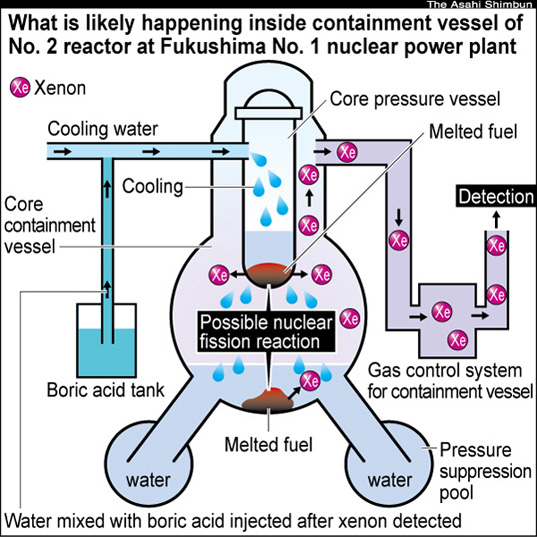You are here

____________________________________________________________________________________________________
By KAZUAKI NAGATA and MIZUHO AOKI - The Japan Times - November 3, 2011
Tepco claims level in gas too small to affect shutdown effort
Although the Nuclear and Industrial Safety Agency said there have been no drastic changes in the reactor's temperature and pressure level, and the reactor itself is stable overall, the discovery may mean the goal of Tepco and the government to achieve cold shutdown of all three crippled reactors by the end of the year may not be possible.
Suggesting that criticality, or a sustained nuclear chain reaction, may have occurred temporarily, or partially, Tepco said one hundred thousandth of a becquerel per cubic centimeter of xenon-133 and xenon-135 was detected in gas samples.
Xenon-133 and xenon-135 are materials created through nuclear fission, and are not usually detected even when a reactor is in operation, as fuel rods are covered with zirconium. This means fission may have occurred in the melted fuel.
As the half-life of these two materials is short — five days for xenon-133 and nine hours for xenon-135, the xenon was probably created recently, but may not have been detected earlier.
Tepco injected boric acid, which can prevent fission, into the reactor Wednesday morning.
Tsuyoshi Misawa, a reactor physics and engineering professor at Kyoto University's Research Reactor Institute, said that if Tepco's data are correct, "it's clear that the detection (of xenon-133 and -135) comes from nuclear fission."
"This amount of xenon would not be detected unless there was a certain degree of fission chain reaction," so it is highly possible criticality took place, Misawa said.
Tepco will conduct detailed research on the gas survey to confirm if the data are accurate.
Yoshinori Moriyama, a NISA spokesman, said there is a possibility fission started from some small pieces of melted fuel. But the fission was probably small and partial, he said, adding, "large-scale fission was unlikely."
He explained that most of the fuel core and control rods, which act to stop fission, may have melted together, so it is hard to imagine that a major criticality accident occurred.
Tepco spokesman Junichi Matsumoto said the test results suggest that either small-scale fission occurred in the melted fuel, or conditions to trigger criticality were temporarily met for some other reason.
He said the same thing could also happen at reactors 1 and 3.
But because the reactor's temperature and pressure level have not changed, the fission would not have been large-scale, Matsumoto said, adding it would not thwart Tepco's schedule for achieving a cold shutdown at the reactors.
Goshi Hosono, the minister overseeing the nuclear crisis, also said Wednesday evening that as the reactor status has remained stable, "we can achieve cold shutdown by the end of the year."
But Misawa said the latest development demonstrates the reactor is still not completely under control, suggesting a cold shutdown remains a long way off.
While continuing to aim for a cold shutdown by year's end, NISA's Moriyama said the important thing is to bring the reactors to a safe and stable status rather than meeting the deadline.



Recent Comments